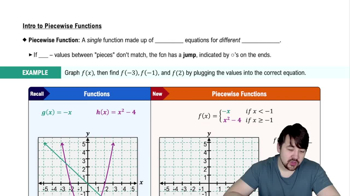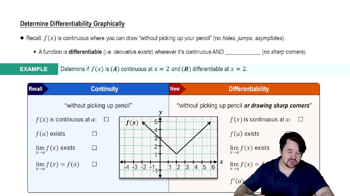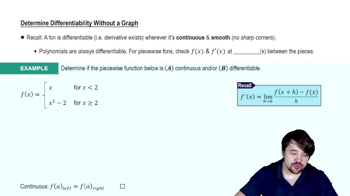Table of contents
- 0. Functions7h 52m
- Introduction to Functions16m
- Piecewise Functions10m
- Properties of Functions9m
- Common Functions1h 8m
- Transformations5m
- Combining Functions27m
- Exponent rules32m
- Exponential Functions28m
- Logarithmic Functions24m
- Properties of Logarithms34m
- Exponential & Logarithmic Equations35m
- Introduction to Trigonometric Functions38m
- Graphs of Trigonometric Functions44m
- Trigonometric Identities47m
- Inverse Trigonometric Functions48m
- 1. Limits and Continuity2h 2m
- 2. Intro to Derivatives1h 33m
- 3. Techniques of Differentiation3h 18m
- 4. Applications of Derivatives2h 38m
- 5. Graphical Applications of Derivatives6h 2m
- 6. Derivatives of Inverse, Exponential, & Logarithmic Functions2h 37m
- 7. Antiderivatives & Indefinite Integrals1h 26m
- 8. Definite Integrals4h 44m
- 9. Graphical Applications of Integrals2h 27m
- 10. Physics Applications of Integrals 2h 22m
2. Intro to Derivatives
Differentiability
Problem 3.67
Textbook Question
a. Graph the function
ƒ(x) = { x², -1 ≤ x < 0
{ -x², 0 ≤ x ≤ 1.
b. Is ƒ continuous at x = 0?
c. Is ƒ differentiable at x = 0?
Give reasons for your answers.
 Verified step by step guidance
Verified step by step guidance1
Step 1: To graph the function ƒ(x), first note that it is a piecewise function with two parts: ƒ(x) = x² for -1 ≤ x < 0 and ƒ(x) = -x² for 0 ≤ x ≤ 1. Plot the graph for each piece separately within their respective intervals.
Step 2: For the interval -1 ≤ x < 0, plot the graph of x². This is a parabola opening upwards, but only consider the portion from x = -1 to just before x = 0.
Step 3: For the interval 0 ≤ x ≤ 1, plot the graph of -x². This is a parabola opening downwards, starting at x = 0 and ending at x = 1.
Step 4: To determine if ƒ is continuous at x = 0, check the left-hand limit (as x approaches 0 from the left) and the right-hand limit (as x approaches 0 from the right). Both limits must equal ƒ(0) for the function to be continuous at x = 0.
Step 5: To determine if ƒ is differentiable at x = 0, check if the derivative from the left-hand side (using x²) and the derivative from the right-hand side (using -x²) are equal at x = 0. If they are not equal, the function is not differentiable at x = 0.
 Verified video answer for a similar problem:
Verified video answer for a similar problem:This video solution was recommended by our tutors as helpful for the problem above
Video duration:
3mPlay a video:
Was this helpful?
Key Concepts
Here are the essential concepts you must grasp in order to answer the question correctly.
Piecewise Functions
A piecewise function is defined by different expressions based on the input value. In this case, the function ƒ(x) has two distinct parts: x² for -1 ≤ x < 0 and -x² for 0 ≤ x ≤ 1. Understanding how to evaluate and graph these segments is crucial for analyzing the function's behavior at specific points, particularly at the transition point x = 0.
Recommended video:

Piecewise Functions
Continuity
A function is continuous at a point if the limit of the function as it approaches that point equals the function's value at that point. For ƒ to be continuous at x = 0, we need to check if the left-hand limit (as x approaches 0 from the left) equals the right-hand limit (as x approaches 0 from the right) and if both equal ƒ(0). This concept is essential for determining the function's smoothness at x = 0.
Recommended video:

Intro to Continuity
Differentiability
A function is differentiable at a point if it has a defined derivative at that point, which requires the function to be continuous there. To check differentiability at x = 0 for ƒ, we must evaluate the left-hand and right-hand derivatives. If these derivatives are not equal, the function is not differentiable at that point, indicating a potential corner or cusp in the graph.
Recommended video:

Finding Differentials

 5:02m
5:02mWatch next
Master Determining Differentiability Graphically with a bite sized video explanation from Callie
Start learningRelated Videos
Related Practice



